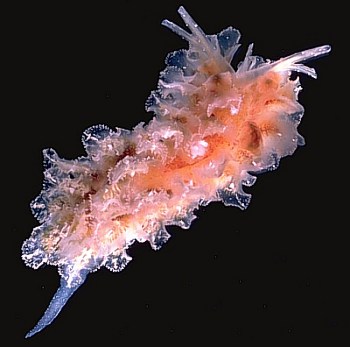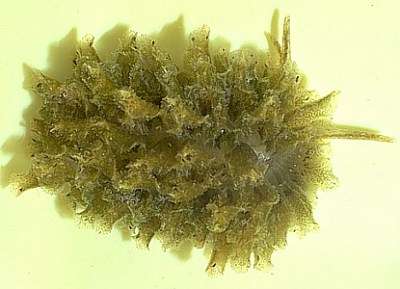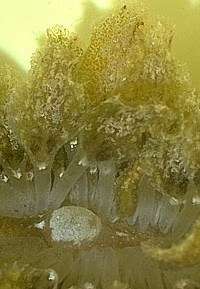
Polybranchia orientalis
(Kelaart, 1858)
Order: SACOGLOSSA
Superfamily: LIMAPONTIOIDEA
Family: Caliphyllidae
DISTRIBUTION
Indo-West Pacific
PHOTO
UPPER RIGHT: Solitary Islands, Coffs Harbour Region, northern New South Wales, Australia, December 1988.
LOWER: Oyster Bay, Dar es Salaam, Tanzania, in pool of Cymodocea, inside algal ridge of reef, May 1973. Closeup on right showing pericardial hump in middle of back and stalked leaf-like cerata on right side of body. The green specks show the fine branching of the digestive gland ducts in the cerata. PHOTOS: Bill Rudman.
Polybranchia orientalis, which was previously know as Phyllobranchus or Phyllobranchillus orientalis is a relatively common member of the Caliphyllidae in the tropical Indo-West Pacific. Members of the family have the back covered in leaf-like cerata, which in Polybranchia and Caliphylla contain fine branching digestive gland ducts, but in Cyerce the digestive gland reaches only into the basal ceratal stalk. The cerata produce sticky secretions from the skin, and in some species, like Polybranchia orientalis, distasteful milky secretions as well, from glands along the edge of the cerata. When disturbed all species are able to cast off their cerata. This is a defensive strategy, called autotomy. New cerata are regrown in a few days.
The main external difference between Polybranchia and Cyerce, is that in Cyerce the sole of the foot has a transverse groove behind the head which is absent in Polybranchia.
Reference:
• Kelaart, E.F. (1858). Description of new and little known species of Ceylon nudibranchiate molluscs and zoophytes. Journal of the Ceylon Branch of the Royal Asiatic Society,
Columbo, 3(1): 84-139.


Rudman, W.B., 1999 (July 5) Polybranchia orientalis (Kelaart, 1858). [In] Sea Slug Forum. Australian Museum, Sydney. Available from http://www.seaslugforum.net/factsheet/polyorie
Related messages
-
Is this poisonous? I think i was stung.
From: Leigh Maulson, May 5, 2006 -
Polybranchia orientalis? from the Red Sea
From: Binyamin Koretz, May 5, 2006 -
Polybranchia orientalis from Singapore
From: Lim Han Peng, July 5, 2005 -
Sacoglossa from the Philippines
From: Erwin Koehler, April 19, 2002 -
Polybranchia orientalis from American Samoa
From: Don Barclay, September 22, 2001 -
Polybranchia orientalis from eastern Australia
From: Grey McNeil, July 5, 1999 -
Cyerce and Polybranchia
From: Bill Rudman, July 5, 1999
